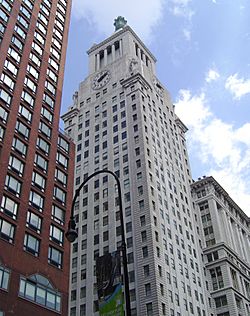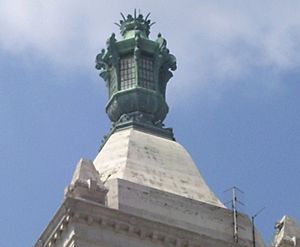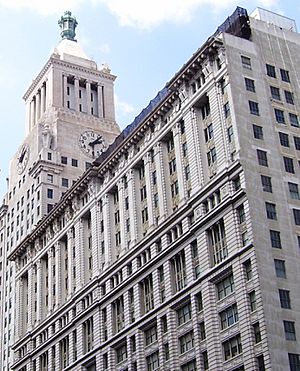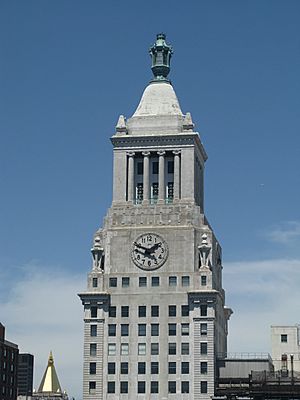Consolidated Edison Building facts for kids
Quick facts for kids Consolidated Edison Building |
|
|---|---|
 |
|
| General information | |
| Type | Commercial offices |
| Architectural style | Beaux-Arts Neoclassical |
| Location | 4 Irving Place Manhattan, New York, US |
| Coordinates | 40°44′03″N 73°59′16″W / 40.7341°N 73.9879°W |
| Construction started | 1911 |
| Completed | 1929 |
| Owner | Consolidated Edison |
| Height | |
| Roof | 513 ft (156 m) |
| Technical details | |
| Floor count | 26 |
| Design and construction | |
| Architect | Warren and Wetmore Henry Hardenbergh |
| Structural engineer | Thomas E. Murray |
| References | |
| Designated: | February 10, 2009 |
| Reference #: | 2313 |
The Consolidated Edison Building is a tall, beautiful building in New York City. It is also known as the Consolidated Gas Building or 4 Irving Place. This 26-story skyscraper is located in the Gramercy Park area of Manhattan. It was designed by famous architects Warren and Wetmore and Henry Janeway Hardenbergh.
The building is the main office for Consolidated Edison, often called Con Ed. This company provides energy to many people in New York. The building takes up a large part of the block between 14th and 15th Streets, and Irving Place and Third Avenue.
Before this building, the site had other important places. These included the Tammany Hall political office and the Academy of Music. Con Ed's older offices were also there. The company needed more space by the 1910s. So, they expanded their building in phases. The first part was built from 1911 to 1914. A much larger section was added between 1926 and 1929.
When it was finished, people loved the building's design. Its special "Tower of Light" became a famous part of the city's skyline. In 2009, the building was named a New York City landmark. This means it's a very important historical building.
History of the Building
Early Days of the Site
Long ago, the land where the building stands belonged to the Lenape Native Americans. In 1651, a large area was given to Peter Stuyvesant. He was a leader of New Netherland. Over time, parts of this land were sold to different people.
In the early 1800s, New York City planned its streets. This plan created Union Square, a park near the building's site. Around the square, new homes and streets like Irving Place were built.
The block where the Consolidated Edison Building is now had many different buildings. There were homes, a church, and a medical school. In 1855, the Manhattan Gas Light Company bought land there. They built an office building. Next to it was the Academy of Music, a famous opera house. It opened in 1854. After a fire in 1866, it was rebuilt. The Tammany Hall political group also built its headquarters on the block.
How the Building Was Built
Hardenbergh's First Design
In the 1880s, several gas companies joined together to form the Consolidated Gas Company. Their old offices were too small by 1910. They had to use other buildings on the block. So, Consolidated Gas hired Henry Janeway Hardenbergh to design a new 12-story office building. He had designed a showroom for them before.
The building was built in two parts so the company could keep working. The first part was built in 1911. It was 62 feet wide and housed the company's smaller offices. Soon, even this was not enough space. Consolidated Gas decided to add seven more floors to the new building. They also bought more land.
Warren and Wetmore's Expansion
After the 19-story building was finished in 1914, Consolidated Gas rented out some extra space. But by the 1920s, the company had grown a lot. They needed even more office space. In 1925, they bought the Academy of Music. It closed in May 1926.
Consolidated Gas then hired Warren and Wetmore to design a big expansion. This firm had designed other offices for the company. The plans were submitted in 1926. The expansion was finished a little over two years later.
The Tammany Hall building on 14th Street was sold in 1927. Tammany Hall moved to a new location. Consolidated Gas bought the old Tammany building in 1928. After this, the Consolidated Gas building became very large. It had over 1 million square feet of space. About 7,000 employees worked there.
What the Building is Used For
In 1932, a guidebook said Consolidated Gas was the "largest company in the world providing electrical service." Four years later, the company changed its name to Consolidated Edison Company of New York. The building was renamed too. By the 1970s, 6,000 people worked at the headquarters. Con Ed still uses the building as its main office today.
The ground floor of the building has been home to different businesses. These include banks and stores. In the 1970s, there were a couple of small incidents that caused minor damage to the building. No one was seriously hurt. By 2010, the ground floor had a gym, a bank, and a furniture store.
The building's outside has not changed much since the 1920s. It was repainted in the 1960s. Some parts were repaired or replaced over the years. For example, the lights on the tower's clock were changed in 1994. The tower and outside walls were fixed from 1997 to 2001. In 2010, it was officially named a city landmark.
Architecture and Design
The Consolidated Edison Building is officially at 4 Irving Place. But it covers lots of space between 2 and 10 Irving Place. The roof is about 404 feet tall. The very top of the lantern is about 478 feet high. The building is made of light-colored stone. Its corners have decorative stone blocks.
Hardenbergh's Design Details
The first part of the building was designed by Hardenbergh. It was one of his last projects. His original plan was for a 12-story building. It would have a limestone outside. The bottom three floors were planned for shops. The middle floors had windows set into special sections. The top floors had windows separated by small columns.
The main entrance was first planned for 15th Street. But when the building was expanded, the main entrance moved to Irving Place. This entrance has a grand porch with columns. The 15th Street entrance is simpler. The original 12 stories stayed mostly the same. But floors 13 through 18 had new designs. They mixed different styles like Beaux-Arts and Neoclassical.
A cool part of Hardenbergh's design was the lighting. Lamps were placed under the roof and on top of the building. The shop windows were also lit up. The light-colored stone helped reflect the light. This made the building shine at night. It was one of the first buildings in New York City to be lit up like this every night. This special lighting was removed when the taller tower was built in the 1920s.
Warren and Wetmore's Tower
The 26-story tower at Irving Place and 14th Street looks a bit like the Metropolitan Life Insurance Company Tower. It has two 18-story sections that wrap around the tower. These sections look similar to Hardenbergh's design. The decorations on the building show its purpose as a power company. You can see symbols like lamps, torches, and suns. These represent light and energy.
The tower rises above the main part of the building. It is set back from the street. This was required by a city rule from 1916. The top of the tower has decorations like urns and obelisks. These honor Con Ed workers who died in World War I.
The very top of the tower is called the "Tower of Light." It looks like a tiny temple. It has a bronze lantern that lights up at night. Below the lantern are columns that also light up with different colors. The tower also has four large clock faces, one on each side. The special lighting for the tower was first turned on in 1929. It was special because it used colored lights, not just plain white. It was also powered by electricity, not gas.
People really liked the new addition. A writer for The New Yorker magazine in 1929 said the tower was "strong and classic." Another magazine called it a building of "unusual merit." The lighting scheme was also praised. In 1939, a guide called it one of the city's "welcome landmarks." In 1981, The New York Times described the Tower of Light as one of the "crowns of light" on the Manhattan skyline.
Images for kids
See also
 In Spanish: Consolidated Edison Building para niños
In Spanish: Consolidated Edison Building para niños





